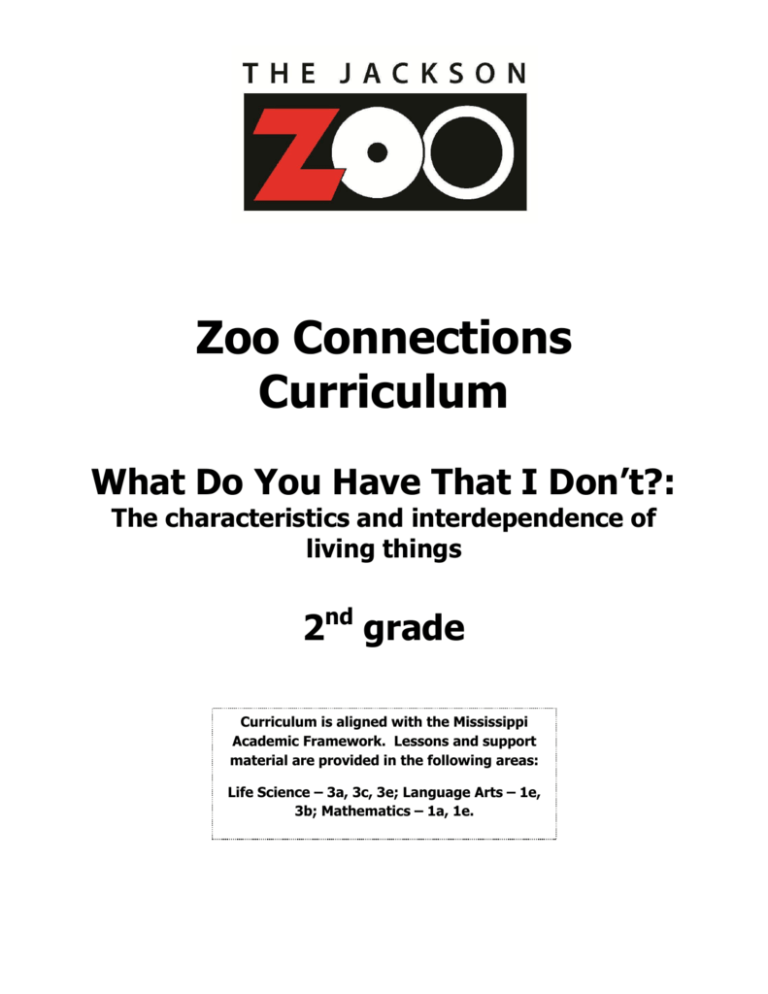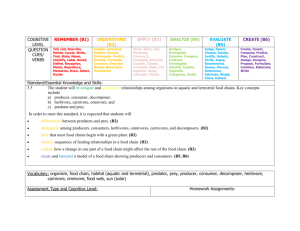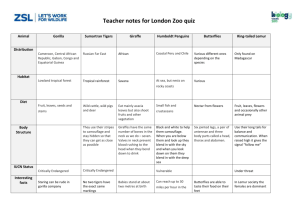What do you have?
advertisement

Zoo Connections Curriculum What Do You Have That I Don’t?: The characteristics and interdependence of living things 2nd grade Curriculum is aligned with the Mississippi Academic Framework. Lessons and support material are provided in the following areas: Life Science – 3a, 3c, 3e; Language Arts – 1e, 3b; Mathematics – 1a, 1e. Pre-Visit Vocabulary Words Herbivore Omnivore Carnivore Predator Prey Cold-Blooded Warm-Blooded Vertebrate Invertebrate Concepts Animals can be grouped in many different ways. All living things depend on each other for survival. Activities Vocabulary Words Introduce the vocabulary words to your class and review their meanings together. Using pictures from magazines, books, or the internet, have the students create a booklet. Take 3 pieces of white paper, fold them in half, put a construction paper cover over the top and staple together. At the bottom of each page, have the students write the vocabulary word and a brief definition. Next, add a picture of an animal the word represents and other helpful pictures to describe the word. They will have more pages then vocabulary words for this activity so you can choose to add to it in the future. Investigation Explain that some animals, vertebrates, have backbones and others, invertebrates, do not. Have the students point to where their backbone is and discuss how it helps them. What would they look like if they did not have it? Explain that insect’s bones are on the outside of their bodies and some animals, like jellyfish, don’t have bones at all. Have pictures of vertebrates and invertebrates for the students to sort into the right category. Food Chain Review the meanings of herbivore, omnivore and carnivore. Give each student or pair of students the Nature Walk activity sheet. Take a nature walk and look for animals. Places to look for wildlife are under rocks, in the sky, trees, and flower beds. If you are unable to go outside, hide pictures around your classroom for the students to find. Have them write down what they find in the correct areas on their sheets. Return to class and create food chains of the animals they saw. If needed, create a list of other Mississippi animals for them to use with their food chains. Discuss what would happen if an animal on their food chain disappeared. Warming Up Have a student stand in front of class and put a heavy jacket, hat, scarf and mittens on him or her. Ask if he or she would get hot if this was worn all day. Discuss how it’s not the jacket that makes us warm, it’s our bodies that make heat. For this reason we are warm-blooded animals. Put the same clothes on a table or chair and ask the students if it would get warmer with all this clothing on it. The answer is no because the object can’t make heat. Some animals, called cold-blooded animals, can’t make their own heat either. These animals need help from outside resources like the sun to help them get warm. Nature Walk Go on a nature walk and look for animals everywhere. When you find one, write what animal you saw into the correct box below. If you are unsure of what it eats, write it in the space below and look it up when you are able to. Look for wildlife in the sky, the ground, under rocks, everywhere! Herbivores Omnivores & Carnivores At the Zoo Remind your students about what they have learned about the many ways animals can be grouped. Have your students work in groups at the zoo to complete the Clever Classification activity sheet. Make enough copies for each group to have one. For ease, if you print it double sided the students will only have one piece of paper to keep track of. Let your students help you teach. Ask them questions that help them discover the information they want to learn. Remind them to read signs and ask any zoo staff member or volunteer any questions that they have! *While every animal is not listed on the Zoo Activity Sheet, we encourage you to visit all of the exhibits. Helpful Zoo Tips: Have your groups of students travel in different directions to avoid overcrowding at animal exhibits. Your students may need some help reading the signs and activity worksheet. Make sure you have a group leader who can help out with this task if needed. Many prey animals can be found in the African Savannah area (Location 22 on your Zoo Map). Many predator animals can be found in the Wilderness Mississippi area (Buildings M, I, J, K & L on your Zoo Map). Clever Classification Zoo Activity Sheet Welcome to the Jackson Zoo! Today you will go on a zoo exploration to discover the ways animals are grouped. Use this activity sheet and a group leader to help you read during your journey as you visit the whole zoo. Have fun discovering our wild world! Monkey Bones What’s for Dinner? (Location 25 or 26 on your Zoo Map) Having a backbone helps animals do many things. Observe the Diana’s Monkeys or Red Tailed Monkeys on the African Trail to see how these vertebrates move. Check the box after you see them do the following things. The beaver is a(n) Climb Sit Groom Chase Grab plants Scratch Eat Move Head Herbivore Omnivore Carnivore It eats Which of these things do you think would be the hardest to do without a backbone? Why do you think that? (Building L on your Zoo Map) Visit the Wetlands Building to discover what some Mississippi animals eat. Helpful signs to read are the Beaver vs. Otter and “Hiss”-teria signs. Circle the word that describes each animal and write down what they eat. The snake is a(n) Herbivore Omnivore Carnivore It eats The otter is a(n) Herbivore Omnivore Carnivore It eats Shining the Light on Snakes (Building J on your Zoo Map) Snakes are cold-blooded animals. To help them keep warm, zookeepers put heat lamps on top of their enclosures. Look in all the snake enclosures to see if the snakes are using their heat lamp. (Look up to find the heat lamp). How many snakes are under their heat lamp? __________ How many snakes were not under their heat lamp? __________ Predator and Prey Scavenger Hunt Look for at least 10 different animals at the zoo today. Find out what they eat; think about what might eat them, then determine if they are a predator and/or prey animal. Put them in the correct location on the chart below. Predator Both What’s for dinner? Prey Post-Visit Vocabulary Give each student a copy of the Animal Mystery Vocabulary Challenge to complete. Comparing Predators and Prey Have the students get into the groups they were in at the zoo. Hand out their Zoo Activity Sheets. Work with them to compile their information from the Predator and Prey Scavenger Hunt activity. Add up the predators, the prey and the animals that fall under both categories. Once the information has been compiled, work together in small groups to compare the numbers using bar graphs, pictographs, <,> and = symbols for example: figure out which type of animal, predator or prey, has the most animals from your activity sheet, or which type of animal is the most common and which one is the least common. Create a Food Chain Using animals from their Predator and Prey Scavenger Hunt activity sheets have the students create their own food chain that contains at least 1 herbivore, 2 omnivores, and 1 carnivore. Have the students share their food chains with the rest of the class. Narrative Project Give each student an 11 x 17 inch white piece paper and fold it in half the short way. On the top of one half, have the students write “vertebrate,” on the other half write “invertebrate.” On the bottom of the paper on each side have them write how they would do a simple task, such as getting dressed or washing the dishes. On the vertebrate side, they will explain how they currently do it. On the invertebrate side, have them write how they would do it if they did not have a backbone. Have them include very specific details about how they move. They should draw a picture of what they look like doing the activity, one as they normally look, and the second how they would look if they didn’t have a backbone. Example: Vertebrate Invertebrate Self Self Portrait Portrait Activity ____________ ____________ ____________ Activity ____________ ____________ ____________ Resources Conservation Snapshots: http://aza.org/conservation-snapshots/ A description of the different types of animal groups and some problems each group is facing in the wild. Animal Diversity Web: Http://animaldiversity.ummz.umich.edu/site/index.html Descriptions of various animal groups and access to links that provide further information. Classifying Animals: www.kn.pacbell.com/wired/fil/pages/listclassifyst.html Links to several websites that provide information about animal groups. How Animals Meet Their Needs: http://www.harcourtschool.com/activity/animalneeds/ An interactive game where students answer questions about the adaptations animals have that help them to survive in their habitats. Recommended Zoo Programs Are you looking for another way to bring the lessons in this curriculum to life? We’ve got just the thing; when you’re at the zoo stop by the Gertrude C. Ford Education building for a fun educational program that supports this material or have the Jackson Zoo come to you! At the Zoo Wild Classroom: Curious Creatures- Why don’t snakes have fur? How come an ostrich has feathers but doesn’t fly? During this exploration of animals, you’ll compare and contrast, discover differences within the animal kingdom, and come away knowing more about why animals look and act the way do, and classified the way they are. Web Spinning- Want to spin a web? First you will need the sun, and then maybe some bugs and worms. Oh, and don’t forget the alligator! What kind of web has all of those things? A food web! There is a lot that goes into spinning one, come on out and learn how. Let us Visit You Zoo Mobile: Animal ABCs- Starting at the beginning has never been this much fun! Find out how we can classify animals based on what they eat, how they eat, if they are hot or cold, or even by their bones (or lack of bones)! Tune up your observation skills as we take a look at these curious creatures. For information on how to schedule any of these programs for your class, visit our website at www.jacksonzoo.org or call 601-352-2580 ext 240. All of these programs must be scheduled at least two weeks in advance. Animal Mystery Vocabulary Challenge Below you will find pictures of animals and clues that describe them. Use both of these to match the correct mystery word to the animal. Warm Blooded Mystery Words Omnivore Carnivore Cold Blooded Vertebrate Animal Clue I eat meat and plants My bones are outside my body I need help from the sun to get warm I have a backbone I eat only plants I eat only meat I can make my own body heat Herbivore Invertebrate Mystery Word






